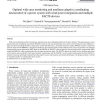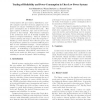7112 search results - page 28 / 1423 » Power in normative systems |
CDC
2010
IEEE
13 years 2 months ago
2010
IEEE
In a wireless communication network different users share a common resource. An objective of radio resource management is to assign the resources in an effective way between the us...
NN
2008
Springer
13 years 7 months ago
2008
Springer
Wide-area coordinating control is becoming an important issue and a challenging problem in the power industry. This paper proposes a novel optimal wide-area coordinating neurocont...
ISQED
2002
IEEE
14 years 14 days ago
2002
IEEE
Critical systems like pace-makers, defibrillators, wearable computers and other electronic gadgets have to be designed not only for reliability but also for ultra-low power consu...
ICC
2007
IEEE
14 years 1 months ago
2007
IEEE
— For Orthogonal Frequency-Division Multiplexing (OFDM) systems, Peak to Average Power Ratio (PAPR) can be a major impediment to efficient transmission due to the need to use in...
GLOBECOM
2007
IEEE
14 years 1 months ago
2007
IEEE
—The high peak-to-average power ratio is a major drawback of OFDM systems. Many PAPR reduction techniques have been proposed in the literature, among them a method that uses a su...


